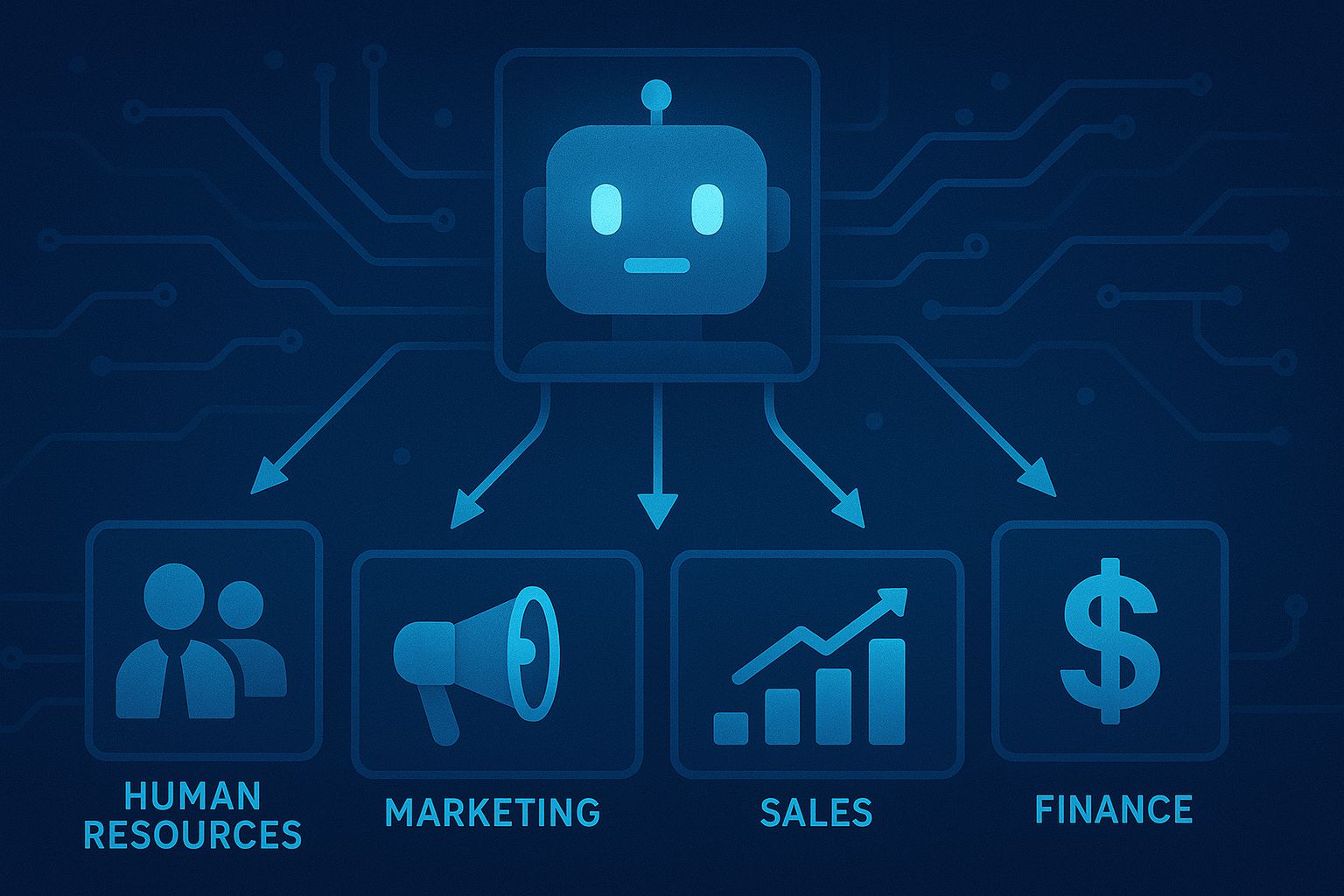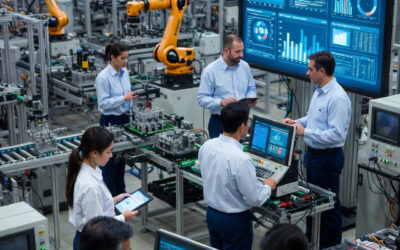The era of generic AI is ending. While organizations have spent the last two years experimenting with ChatGPT and other horizontal AI tools, a fundamental shift is underway that will redefine how every department operates.
Welcome to the age of Vertical AI—where intelligence isn’t just bolted onto your business but woven into its fabric.
The Fundamental Shift: From Features to Operating Systems
Horizontal AI tools like ChatGPT are impressive technological achievements. They can write, analyze, and create across infinite domains. But here’s their fatal flaw: they operate in isolation from your business reality.
Consider the typical workflow: copy data from your system, paste it into ChatGPT, get a response, then manually transfer that insight back into your processes. This friction multiplies across every use case, every day, across every employee.
Vertical AI eliminates this friction entirely. It doesn’t sit alongside your business…it becomes your business’s intelligent operating system. The difference isn’t incremental; it’s transformational.
Why Vertical AI Changes Everything
Three fundamental characteristics separate Vertical AI from its horizontal predecessors:
1. Your Data as the Foundation While horizontal AI operates on generic knowledge, Vertical AI is built on your proprietary data lake. This isn’t just about access—it’s about context. Every decision, every recommendation, every action is informed by your unique business history, patterns, and relationships.
2. Process Integration, Not Feature Addition Vertical AI doesn’t require you to change how you work. Instead, it enhances your existing processes with intelligence. No more context switching, no more manual transfers, just seamless augmentation of your current workflows.
3. Adaptive Intelligence Unlike rigid automation that breaks with every change, Vertical AI adapts. It learns from your operations, evolves with your business, and improves continuously. The models may be commoditized, but your implementation becomes your competitive moat.
The Department-by-Department Revolution
Finance: From Manual Processing to Intelligent Operations
The Current State: Finance teams drown in manual invoice processing, spending 85% of their time on data entry and validation rather than strategic analysis.
The Vertical AI Transformation: Consider the Invoice Processing Agent already transforming accounting departments. It doesn’t just scan invoices—it understands them. The system ingests invoices from any source, extracts line items with 99.2% accuracy, maps them to your specific GL codes, and uploads directly to your ERP.
One energy company reduced invoice processing time and reclaimed 40+ hours monthly for strategic work. But the real transformation? Their finance team now focuses on optimizing cash flow and identifying cost-saving opportunities rather than drowning in paperwork.
What This Means for CFOs: Your team becomes strategic advisors, not data processors. Real-time financial intelligence replaces weekly reports. Audit trails are automatic and comprehensive.
Operations: From Reactive to Predictive
The Current State: Operations teams fight fires daily, reacting to demand spikes, supply disruptions, and resource constraints with outdated information.
The Vertical AI Transformation: The Supply Chain Forecasting Agent exemplifies the shift from reactive to predictive operations. By analyzing historical patterns, market trends, and external factors, it predicts demand across territories with unprecedented accuracy.
MDLIVE saved $2 million annually by accurately forecasting service demands, reducing wait times by 50% while handling 40,000 additional patients. The key? Their AI doesn’t just predict—it prescribes actions and automatically adjusts resource allocation.
What This Means for COOs: Transform from firefighting to strategic optimization. See problems before they occur. Allocate resources based on intelligence, not instinct.
Sales & Customer Success: From Transactional to Relationship-Driven
The Current State: Sales teams waste 60% of their time on administrative tasks. Customer success struggles with engagement, facing 30% no-show rates and customer churn.
The Vertical AI Transformation: The Customer Engagement Agent revolutionizes how organizations interact with customers. It enables 24/7 self-scheduling, sends intelligent reminders based on individual patterns, and automatically re-engages lapsed customers through their preferred channels.
Healthcare providers using this technology report 30% reduction in no-shows and 15% increase in bookings through automated re-engagement. But the deeper impact? Staff now focus on building relationships rather than chasing appointments.
What This Means for Revenue Leaders: Every customer interaction becomes an opportunity. Engagement happens automatically. Your team focuses on value creation, not administration.
Supply Chain & Field Operations: From Chaos to Orchestration
The Current State: Service organizations struggle with unpredictable demand patterns, inefficient routing, and capacity constraints. Field teams are either sitting idle or overwhelmed, while customers face long wait times and scheduling frustrations.
The Vertical AI Transformation: The Service Scheduling Optimization Agent revolutionizes how organizations manage their service delivery. This isn’t just about booking appointments—it’s about intelligent capacity optimization across your entire operation.
The system predicts no-show patterns, dynamically adjusts visit durations based on service type and history, and creates custom scheduling rules that balance efficiency with customer satisfaction. One behavioral health organization achieved 20% increase in scheduled capacity without adding a single resource, while simultaneously improving customer access and reducing wait times.
What This Means for Operations Leaders: Transform reactive firefighting into proactive optimization. Know exactly when and where demand will spike. Maximize every hour of capacity while improving both customer and employee satisfaction. Turn scheduling from a constraint into a competitive advantage.
IT: From Support to Innovation
The Current State: IT departments typically spend 70-80% of their time maintaining systems and responding to tickets rather than driving innovation.
The Vertical AI Transformation: The AI Data Analyst represents the future of IT’s role. Instead of building reports, IT enables self-service intelligence. Any employee can ask natural language questions and receive instant, accurate insights from across all enterprise systems.
One manufacturing company saw an increase in data-driven decision-making after implementing this capability. IT’s role shifted from report generation to ensuring data quality and governance—a far more strategic contribution.
What This Means for CIOs: Transform from service provider to innovation enabler. Focus on architecture and governance, not ticket resolution. Become the orchestrator of intelligence across the enterprise.
The Compound Effect of Departmental Transformation
When every department operates with Vertical AI, the effects compound exponentially:
- Cross-Functional Intelligence: Finance’s invoice data informs Operations’ demand forecasting, which drives Sales’ targeting, which influences HR’s hiring plans.
- Unified Truth: No more conflicting reports or data silos. Every department operates from the same intelligent foundation.
- Accelerated Decision-Making: Insights that took weeks now happen in real-time. Decisions are informed by comprehensive intelligence, not partial information.
- Continuous Improvement: Every interaction, every transaction, every decision feeds back into the system, making it smarter for everyone.
Building Your Vertical AI Operating System
The journey from horizontal tools to Vertical AI requires a fundamental shift in thinking:
Start with Integration, Not Isolation
Don’t deploy another tool. Build an intelligent layer that enhances everything you already have. Your ERP, CRM, HRIS they all become smarter, not replaced.
Focus on Workflows, Not Features
Identify the workflows that consume the most time with the least strategic value. These become your first Vertical AI implementations, creating immediate ROI while building organizational confidence.
Design for Evolution
Your Vertical AI system should improve continuously. Every process completion, every decision made, every outcome achieved becomes training data for better future performance.
Prioritize Data Unification
The power of Vertical AI comes from comprehensive data access. Break down silos before building intelligence. A unified data lake isn’t optional…it’s foundational.
The Competitive Imperative
Organizations implementing Vertical AI today aren’t just improving efficiency, they’re creating insurmountable competitive advantages:
- Speed: Decisions that took days happen instantly
- Accuracy: Human error virtually eliminated from routine processes
- Scale: Handle more volume without more headcount
- Innovation: Free human creativity by eliminating mundane tasks
- Resilience: Adapt to changes automatically rather than breaking
The gap between Vertical AI adopters and traditional operators widens daily. Every process optimized, every insight gained, every hour saved compounds into competitive advantage.
The Human Element: Amplification, Not Replacement
The most successful Vertical AI implementations share a crucial understanding: this isn’t about replacing humans but amplifying human capability.
When finance professionals spend time on strategy rather than data entry, when sales teams focus on relationships rather than administration, when HR builds culture rather than processes paperwork—that’s when organizations truly transform.
Vertical AI handles the predictable so humans can master the exceptional.
The Path Forward
The transition from experimental AI to operational AI—from horizontal to vertical—isn’t optional. It’s the defining business transformation of this decade.
For every department, the question isn’t whether to adopt Vertical AI but how quickly you can integrate it into your operations. The tools exist. The patterns are proven. The early adopters are already reaping rewards.
Start with one department, one workflow, one pain point. Build your first Vertical AI implementation. Experience the transformation. Then expand, integrate, and compound the benefits across your entire organization.
Because in the age of AI, competitive advantage doesn’t come from having access to the same tools everyone else uses. It comes from building intelligent operations that continuously learn, adapt, and improve based on your unique business reality.
The organizations that understand this…that move from AI as a feature to AI as an operating system—will define the next era of business.
The rest will wonder how they fell so far behind.
Vertical AI isn’t just another technology trend. It’s the fundamental reorganization of how businesses operate—and every department will be transformed by it.




